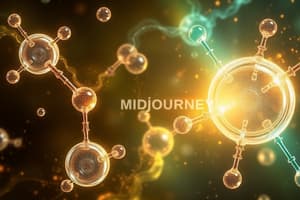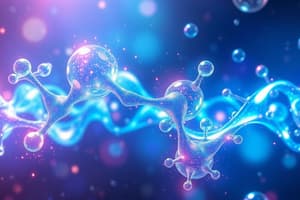Podcast
Questions and Answers
What occurs during dynamic equilibrium?
What occurs during dynamic equilibrium?
- Energy is continuously absorbed from the surroundings.
- The forward reaction ceases completely.
- Only the reverse reaction takes place.
- The rates of the forward and reverse reactions are equal. (correct)
Which principle describes how a system at equilibrium responds to disturbances?
Which principle describes how a system at equilibrium responds to disturbances?
- Gibbs Free Energy
- Newton's Third Law
- Conservation of Mass
- Le Chatelier's Principle (correct)
What is the definition of a mole in chemistry?
What is the definition of a mole in chemistry?
- A unit equivalent to 6.022 x 10²³ particles. (correct)
- The volume of one liter of solution.
- The mass of a substance in grams.
- A measurement of temperature.
Which type of reaction absorbs energy from its surroundings?
Which type of reaction absorbs energy from its surroundings?
What must balanced chemical equations achieve?
What must balanced chemical equations achieve?
What are the smallest units of matter?
What are the smallest units of matter?
Which type of bond is formed by the sharing of electrons?
Which type of bond is formed by the sharing of electrons?
What is the correct representation for water as a compound?
What is the correct representation for water as a compound?
What defines a substance as an acid?
What defines a substance as an acid?
Which process describes a reaction where one compound breaks down into simpler products?
Which process describes a reaction where one compound breaks down into simpler products?
What is a characteristic of gases compared to solids and liquids?
What is a characteristic of gases compared to solids and liquids?
What type of reaction involves the exchange of ions between two compounds?
What type of reaction involves the exchange of ions between two compounds?
Which statement describes how elements are organized in the periodic table?
Which statement describes how elements are organized in the periodic table?
Flashcards are hidden until you start studying
Study Notes
Basic Concepts in Chemistry
- Matter: Anything that has mass and occupies space; can exist in solid, liquid, or gas states.
- Atoms: The smallest units of matter; consist of protons, neutrons, and electrons.
- Protons: Positively charged particles found in the nucleus.
- Neutrons: Neutral particles found in the nucleus.
- Electrons: Negatively charged particles that orbit the nucleus.
Elements and Compounds
- Elements: Pure substances that cannot be broken down into simpler substances; represented by symbols (e.g., H for hydrogen).
- Compounds: Substances formed from two or more elements chemically bonded together (e.g., H2O for water).
Chemical Bonds
- Ionic Bonds: Formed when electrons are transferred from one atom to another, resulting in charged ions (e.g., NaCl).
- Covalent Bonds: Formed when two atoms share electrons (e.g., O2).
- Metallic Bonds: Characterized by a sea of delocalized electrons shared among a lattice of metal ions.
Chemical Reactions
- Reactants: Substances that undergo change during a chemical reaction.
- Products: Substances formed as a result of a chemical reaction.
- Types of Reactions:
- Synthesis: Two or more reactants combine to form a single product (A + B → AB).
- Decomposition: A single compound breaks down into simpler products (AB → A + B).
- Single Replacement: One element replaces another in a compound (A + BC → AC + B).
- Double Replacement: The exchange of ions between two compounds (AB + CD → AD + CB).
- Combustion: A reaction with oxygen, producing energy, carbon dioxide, and water (e.g., CxHy + O2 → CO2 + H2O).
States of Matter
- Solids: Definite shape and volume; particles are closely packed.
- Liquids: Definite volume but take the shape of their container; particles are close but can move past each other.
- Gases: No definite shape or volume; particles are far apart and move freely.
The Periodic Table
- Organization: Elements are arranged by increasing atomic number; grouped by similar properties.
- Groups (Columns): Elements with similar chemical behaviors (e.g., alkali metals, halogens).
- Periods (Rows): Indicate the number of electron shells.
Acids and Bases
- Acids: Substances that donate protons (H+) and have a sour taste; pH < 7.
- Bases: Substances that accept protons and feel slippery; pH > 7.
- pH Scale: Ranges from 0 to 14; measures acidity or alkalinity.
Chemical Equilibrium
- Dynamic Equilibrium: The rates of the forward and reverse reactions are equal.
- Le Chatelier's Principle: If a dynamic equilibrium is disturbed, the system adjusts to counteract the change.
Stoichiometry
- Mole: A unit of measurement for amount of substance, equivalent to 6.022 x 10²³ particles.
- Balanced Chemical Equations: Must have equal numbers of each type of atom on both sides to conserve mass.
Thermodynamics in Chemistry
- Exothermic Reactions: Release energy, usually in the form of heat (e.g., combustion).
- Endothermic Reactions: Absorb energy from the surroundings (e.g., photosynthesis).
Conclusion
- Chemistry is the study of matter, its properties, and how it interacts and changes.
- Understanding basic concepts and principles is essential for exploring more advanced topics in chemistry.
Basic Concepts in Chemistry
- Matter consists of anything that possesses mass and occupies space, existing in solid, liquid, or gas forms.
- Atoms, the fundamental units of matter, are composed of protons, neutrons, and electrons.
- Protons carry a positive charge and reside in the nucleus of the atom.
- Neutrons are neutral particles located in the nucleus.
- Electrons are negatively charged and orbit the nucleus around it.
Elements and Compounds
- Elements are pure substances that cannot undergo chemical breakdown into simpler substances and are denoted by symbols, such as H for hydrogen.
- Compounds are formed by the chemical bonding of two or more elements, like H2O representing water.
Chemical Bonds
- Ionic bonds involve the transfer of electrons between atoms, leading to the formation of charged ions, exemplified by sodium chloride (NaCl).
- Covalent bonds result from the sharing of electrons between two atoms, as seen in oxygen gas (O2).
- Metallic bonds feature a framework of metal ions surrounded by a sea of delocalized electrons, allowing conductivity.
Chemical Reactions
- Reactants are the initial substances that undergo transformation during a chemical reaction.
- Products are the new substances produced from a chemical reaction.
- Types of reactions include:
- Synthesis: Combination of multiple reactants into one product (A + B → AB).
- Decomposition: Breakdown of a single compound into simpler products (AB → A + B).
- Single Replacement: An element substitutes another in a compound (A + BC → AC + B).
- Double Replacement: Exchange of ions between two compounds (AB + CD → AD + CB).
- Combustion: Reaction with oxygen, yielding energy, carbon dioxide, and water (CxHy + O2 → CO2 + H2O).
States of Matter
- Solids exhibit a fixed shape and volume with tightly packed particles.
- Liquids have a definite volume that adapts to the shape of their container, allowing particles to move past one another.
- Gases lack a fixed shape or volume, with widely spaced particles moving freely.
The Periodic Table
- Elements are arranged in the periodic table by increasing atomic number, categorized based on similar properties.
- Groups (columns) contain elements with comparable chemical behaviors, like alkali metals and halogens.
- Periods (rows) correspond to the number of electron shells in the elements.
Acids and Bases
- Acids donate protons (H+) and typically have a sour taste, exhibiting a pH less than 7.
- Bases accept protons and feel slippery, resulting in a pH greater than 7.
- The pH scale, ranging from 0 to 14, gauges the acidity or alkalinity of substances.
Chemical Equilibrium
- Dynamic equilibrium occurs when the rates of the forward and reverse chemical reactions are balanced.
- Le Chatelier's Principle indicates that a system in dynamic equilibrium will respond to disturbances by adjusting to restore balance.
Stoichiometry
- A mole represents a fundamental unit for measuring substance quantity, equivalent to approximately 6.022 x 10²³ particles.
- Balanced chemical equations maintain equal numbers of each type of atom on both sides, adhering to the law of conservation of mass.
Thermodynamics in Chemistry
- Exothermic reactions release energy, primarily as heat (e.g., combustion reactions).
- Endothermic reactions absorb energy from their surroundings (e.g., during photosynthesis).
Conclusion
- Chemistry is defined as the study of matter, focusing on its properties and interactions.
- Mastery of basic concepts in chemistry is crucial for delving into more advanced topics in the field.
Studying That Suits You
Use AI to generate personalized quizzes and flashcards to suit your learning preferences.




